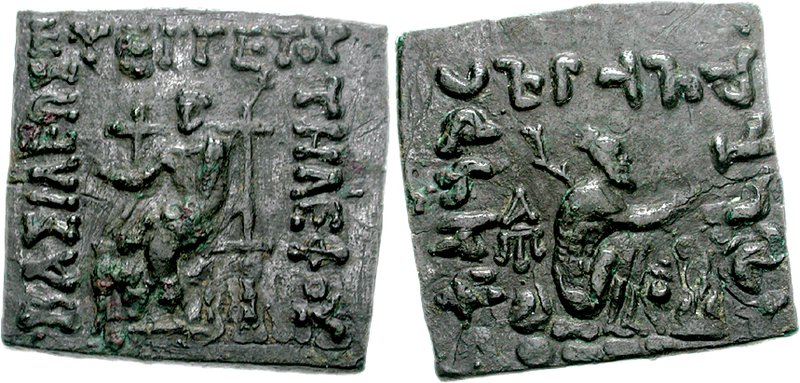Telephos Euergetes on:
[Wikipedia]
[Google]
[Amazon]
 Telephus Euergetes ( grc, Τήλεφος Εὐεργέτης, Tēlephos Euergetēs; ''
Telephus Euergetes ( grc, Τήλεφος Εὐεργέτης, Tēlephos Euergetēs; ''
Coins of Telephus
{{DEFAULTSORT:Telephos Indo-Greek kings 1st-century BC rulers in Asia
 Telephus Euergetes ( grc, Τήλεφος Εὐεργέτης, Tēlephos Euergetēs; ''
Telephus Euergetes ( grc, Τήλεφος Εὐεργέτης, Tēlephos Euergetēs; ''Euergetes ( grc, Εὐεργέτης, ), meaning "the Benefactor" (from , "good", + , "doer, worker"), was an epithet, an honoring title, given to various benefactors. Euergetism (literally "doing good deeds") was the practice of high-status and wealthy in ...
'' means "the Benefactor") was a late Indo-Greek
The Indo-Greek Kingdom, or Graeco-Indian Kingdom, also known historically as the Yavana Kingdom (Yavanarajya), was a Hellenistic period, Hellenistic-era Ancient Greece, Greek kingdom covering various parts of Afghanistan and the northwestern r ...
king who seems to have been one of the weak and brief successors of Maues
Maues (Greek: ; (epigraphic); Kharosthi: , , called , on the Taxila copper plate; also called , in the Mathura lion capital inscription,) was the first Indo-Scythian king, ruling from 98/85 to 60/57 BCE. He invaded India and establishe ...
. Bopearachchi dates Telephus between 75–70 BCE and places him in Gandhara, Senior to c. 60 BCE and suggests that he ruled in some parts of Pushkalavati or even further west.
Nothing is known about his dynastic connections. His few coins are rather singular and none of them bear his likeness, a rare occurrence in Indo-Greek coinage. Despite his Greek name, Telephus might therefore have been a ruler of Saka
The Saka ( Old Persian: ; Kharoṣṭhī: ; Ancient Egyptian: , ; , old , mod. , ), Shaka (Sanskrit ( Brāhmī): , , ; Sanskrit (Devanāgarī): , ), or Sacae (Ancient Greek: ; Latin: ) were a group of nomadic Iranian peoples who hist ...
origin. His epithet was also unprecedented.
Coinage
The silver coinage of Telephus is rare and mostly consists ofdrachm
The dram (alternative British spelling drachm; apothecary symbol ʒ or ℨ; abbreviated dr) Earlier version first published in ''New English Dictionary'', 1897.National Institute of Standards and Technology (October 2011). Butcher, Tina; Cook, ...
s; only a few tetradrachm
The tetradrachm ( grc-gre, τετράδραχμον, tetrádrachmon) was a large silver coin that originated in Ancient Greece. It was nominally equivalent to four Greek drachma, drachmae. Over time the tetradrachm effectively became the standard ...
s are known. On the Greek side is a serpent-footed monster holding the stems of two plants, and on the Kharoshthi
The Kharoṣṭhī script, also spelled Kharoshthi (Kharosthi: ), was an ancient Indo-Iranian script used by various Aryan peoples in north-western regions of the Indian subcontinent, more precisely around present-day northern Pakistan and ...
side two deities that probably should be identified with Helios
In ancient Greek religion and Greek mythology, mythology, Helios (; grc, , , Sun; Homeric Greek: ) is the deity, god and personification of the Sun (Solar deity). His name is also Latinized as Helius, and he is often given the epithets Hyper ...
and Selene
In ancient Greek mythology and religion, Selene (; grc-gre, Σελήνη , meaning "Moon"''A Greek–English Lexicon's.v. σελήνη) is the goddess and the personification of the Moon. Also known as Mene, she is traditionally the daughter o ...
, the sun and moon. Both types were unique in the area, though the monster would later appear on bronzes of Hippostratus
Hippostratus ( grc, Ἱππόστρατος, Hippostratos) was an Indo-Greek king who ruled central and north-western Punjab and Pushkalavati. Bopearachchi dates Hippostratus to 65 to 55 BCE whereas R. C. Senior suggests 60 to 50 BCE.
Rule
In B ...
.
An example of one of his bronzes is seen above, The obverse is the common type of sitting Zeus making a benediction gesture, whereas on the reverse is the unique type of a squatting man holding what on some specimens looks like a spear, on others a palm branch.
Telephus used only two monograms, which he inherited from Maues
Maues (Greek: ; (epigraphic); Kharosthi: , , called , on the Taxila copper plate; also called , in the Mathura lion capital inscription,) was the first Indo-Scythian king, ruling from 98/85 to 60/57 BCE. He invaded India and establishe ...
.
Overstrikes
Telephos overstruck the earlier kingArchebius
Archebius Dikaios Nikephoros (Greek: ; epithets mean respectively, "the Just", "the Victorious"; formerly read as "Archelius") was an Indo-Greek king who ruled in the area of Taxila. Osmund Bopearachchi dates him to c. 90–80 BCE, and R. C. ...
.
See also
*Greco-Bactrian Kingdom
The Bactrian Kingdom, known to historians as the Greco-Bactrian Kingdom or simply Greco-Bactria, was a Hellenistic period, Hellenistic-era Hellenistic Greece, Greek state, and along with the Indo-Greek Kingdom, the easternmost part of the Helleni ...
* Greco-Buddhism
Greco-Buddhism, or Graeco-Buddhism, is the cultural syncretism between Hellenistic culture and Buddhism, which developed between the fourth century BC and the fifth century AD in Gandhara, in present-day north-western Pakistan and parts of nort ...
* Indo-Scythians
Indo-Scythians (also called Indo-Sakas) were a group of nomadic Iranian peoples of Scythian origin who migrated from Central Asia southward into modern day Pakistan and Northwestern India from the middle of the 2nd century BCE to the 4th centur ...
* Indo-Parthian Kingdom
The Indo-Parthian Kingdom was a Parthian kingdom founded by Gondophares, and active from 19 CE to c. 226 CE. At their zenith, they ruled an area covering parts of eastern Iran, various parts of Afghanistan and the northwest regions of the Indian ...
* Kushan Empire
The Kushan Empire ( grc, Βασιλεία Κοσσανῶν; xbc, Κυϸανο, ; sa, कुषाण वंश; Brahmi: , '; BHS: ; xpr, 𐭊𐭅𐭔𐭍 𐭇𐭔𐭕𐭓, ; zh, 貴霜 ) was a syncretic empire, formed by the Yuezhi, i ...
References
* ''The Greeks in Bactria and India'', W. W. Tarn, Cambridge University Press. * ''The Coin Types of the Indo-Greek Kings, 256-54 B.C.'', A. K. Narain.External links
Coins of Telephus
{{DEFAULTSORT:Telephos Indo-Greek kings 1st-century BC rulers in Asia